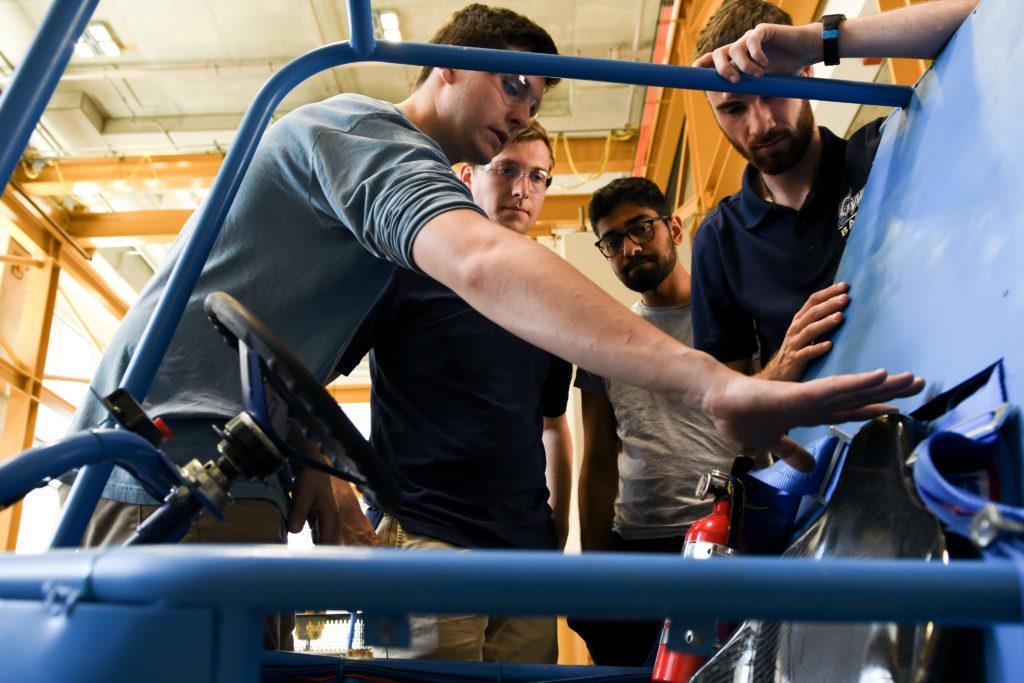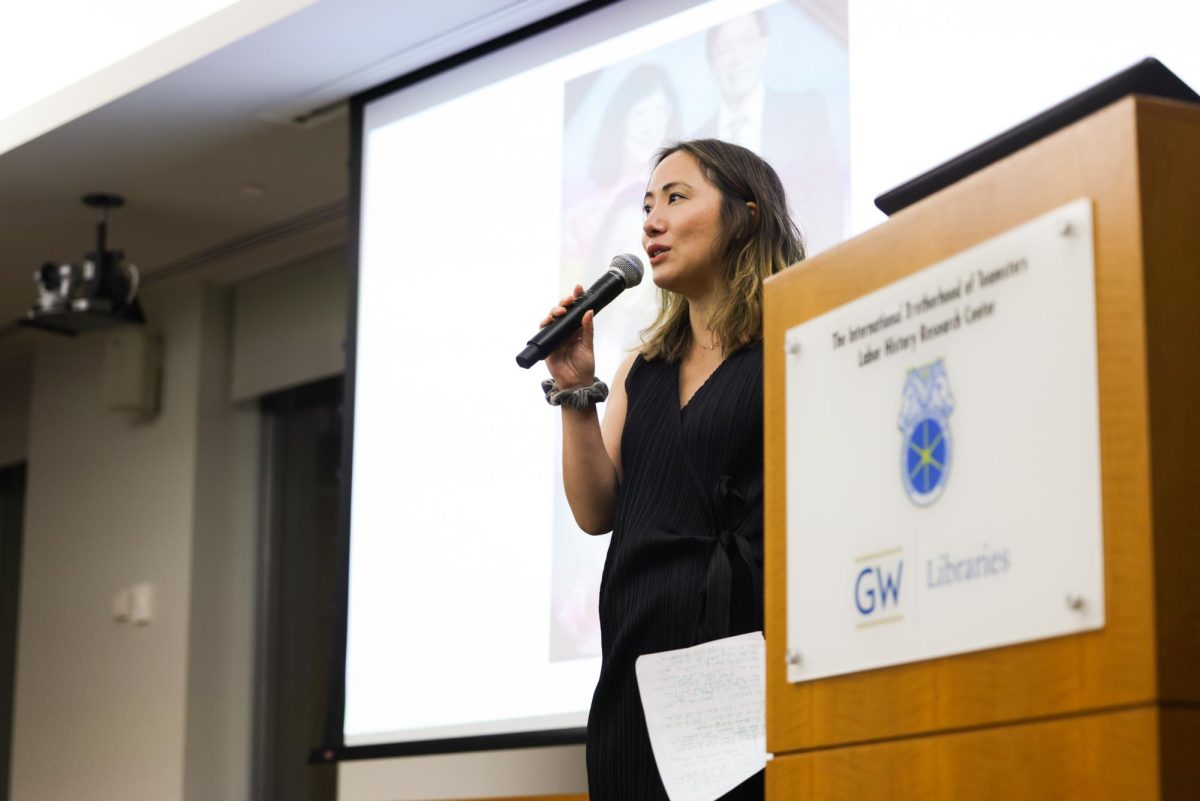For a team of student engineers at work in the Science and Engineering Hall, the overwhelming smell of sawdust and endless drone of high-pitched metal scraping is almost more routine than their sleep schedules.
The team – a group of 15 students from the School of Engineering and Applied Science – has worked since August to craft an off-road vehicle for an international competition. They are preparing for the Society of Automotive Engineers’ annual Baja competition this weekend, where a car they created will be judged alongside more than 100 teams from universities around the world.
The car is a four-wheeled off-roader fit for one person, and resembles a spray-painted blue dune buggy with the GW insignia glazed on the car door.
The engineering students work on the vehicle at SEH’s upper high bay, which can be seen through the large glass panes on the 23rd Street side of the building. The workplace has a constant stream of grinding, welding and clanking that the team’s co-captain Conor Gillespie referred to as “pure madness.”
“One of the best feelings I’ve ever had in life is when I put so much work into building something and so much effort into designing something, and at the end of the day I can actually see it come to fruition,” Gillespie said. “It’s one of the coolest feelings.”
Gillespie and co-captain Andrew Edzenga, both juniors studying mechanical engineering, jokingly deemed the vehicle “Baby Blue” from the vehicle’s paint color after being pressured to think of a name.
The team makes each car part from scratch, aside from essentials like the engine and breaks. The group will soon disassemble it and pack it up for the trip to the competition in Maryland – where they’ll need to reassemble the car for the race.
The Baja SAE competition includes a thorough examination of each vehicle, judged on numerous categories by an expert in each field. First, students must discuss their vehicle in a design presentation with a group of automotive experts, who ask questions about each design choice and function. Then, the team must pitch the car as if selling it to the mass market in a business-oriented critique.
Tests are run on the vehicle’s capability, which includes breaking, sharp turns, acceleration and hill climbing. The main event is an endurance course where a group member runs laps around a more than two mile track for four hours. Last year, the track contained rocky terrain and water obstacles, and a majority of the vehicles crumbled midway through the race, Gillespie said.
The competition will be held at Budd’s Creek in Mechanicsville, Md., and takes place Thursday through Sunday, but two other events are held in the U.S. during the year.
“Their idea when they design this course is basically to break your car,” Gillespie said.
The team – a volunteer club that resets its roster each year – sat out of competition last year because the car wasn’t functioning. It wouldn’t pass the judges’ nearly 15-page checklist for inspection that happens before the races even begin.
When Gillespie and Edzenga were freshmen in 2016, the team was unprepared for the rigor of the critiques and the frame that held the car’s engine failed on the second hour of the endurance course. Edzenga and Gillespie didn’t get to ride the vehicle as freshmen, so they made sure with this car, each student could get time at the steering wheel. They delegated design aspects to group subsections, with upperclassmen mentoring freshmen in the car’s assembly.
Edzenga said the previous car’s “huge” weight was poorly distributed in the back, and getting over jumps caused a slow down during the race.
“We just thought we had to put the car together and race it, but there turned out to be so many other facets that we just weren’t aware of,” Edzenga said.
Murray Snyder, a professor of mechanical engineering and the team’s faculty advisor, said that a shift in the group’s retention and attitude was in part from the co-captains’ leadership.
“This year, people who have joined the team have stayed very involved and I think a lot of that can be attributed to the effective leadership of the team leaders,” Snyder said. “They’re very good at keeping people working together and heading toward a common goal.”
Starting the new car in August, they initially worked 20 hours per week, but as the spring semester revved up, they shifted to a 40-hour work week, completing homework early to work on the car over the weekend. Now the team feels more prepared than ever to present the car for competition.
Edzenga and Gillespie said their previous shortcomings provided a blueprint for what to avoid with this year’s car. To avoid another 529-pound heavyweight, they created an “ultra lightweight” carbon fiber seat along with a better-planned design, shaving 60 pounds off the vehicle.
The car now weighs 467 pounds, and Edzenga said its parts are assembled as a unit, where each car part serves multiple functions.
“Moving into this year, we had a big focus on how to design the car to make everything as light as possible using the best engineering practices,” Edzenga said. “We’re looking at the car as a full system rather than individual parts that are just kind of glued together.”
At their practice ground on the Virginia Science and Technology Campus, the car has successfully survived two test drives on its diverse terrain.
“I’ve driven it. I actually went off a jump the other day, did a complete front flip and got shaken around a little bit, but it was a lot of fun and I came out fine,” Gillespie said. “I trust the car, it’s been through tests, and we’ve put blood, sweat and tears into it.”




